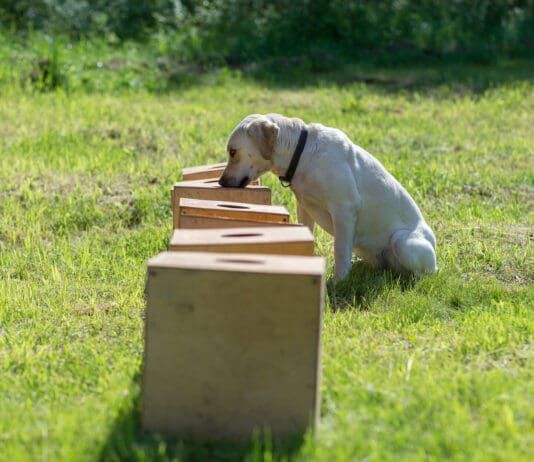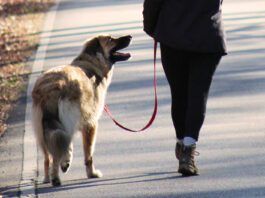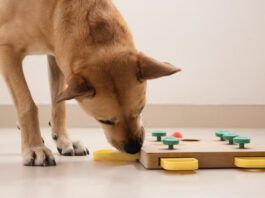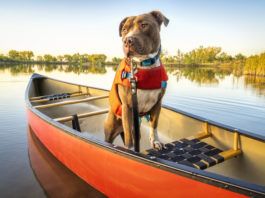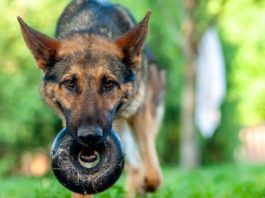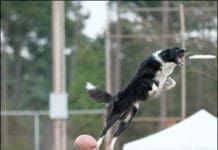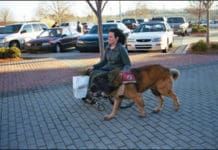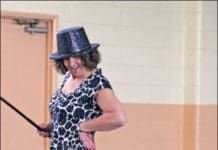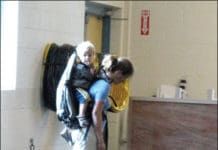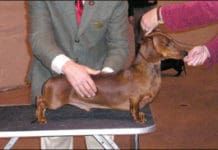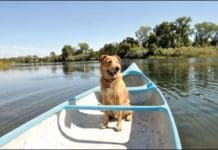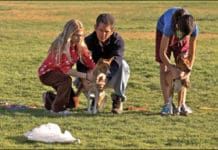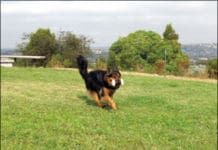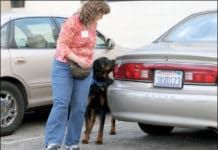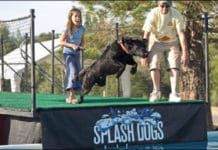Canine Sports: Herding Competitions
Fetch. Drive. Flank. Come-bye. Go-bye. Way to me. Outruns. Flight zones. Pressure point. That'll do! The sport of herding has a unique vocabulary that distinguishes it from all the other canine sports. In addition to basic obedience cues such as sit, down, stay, and come, dogs are trained to respond to cues that tell them when to start moving livestock, in which direction to move them, when to stop moving them, when and how to move them into pens, and how to use their physical presence to pressure the stock to move but not to scare them into running or stampeding. There is dirt, there is dust, there is livestock that can break bones and bruise a body, and there is livestock poop. And herding teams love it all.
Disc Dog Competitions
The cattle dog-mix races across the turf, his claws digging into the ground, pushing hard into his next stride, building momentum, faster, faster, faster. With a final turbo blast powered by his rear legs, he pushes off the ground and vaults into the air, seemingly weightless as he stretches his neck into the sky. A sudden twist of shoulders propels his torso and hips 180 degrees as he changes direction midair and snatches the prize from the air - a simple, round plastic disc. Eyes alight with the thrill of the chase and the kill (catch), he lands nimbly and races back to his handler. Can we do it again? Can we, can we? Yeah, we can. This is the sport of disc dog. It's been around since Frisbees became popular in the early 1970s and the players' dogs chased the players' errant tosses. When a bad toss resulted in a disc rolling on its side, that was fine by Fido.
Agility Sports That are Perfect for the Action Junkie in Your Canine
Agility is probably the most popular and best known of all the sports for canine athletes. It's easy to see why. Your dog gets to do what dogs like to do: move around, jump, run, climb on things, and play! Agility is a high-speed sport in which the handler directs her dog through an obstacle course of jumps, tunnels, weave poles, teeter-totter, and other obstacles. The goal is for the dog to complete the course without exceeding the standard course time" and without incurring any "faults." Faults include knocking jump bars
Dog Carting and Draft Training
What do you envision when someone says “draft work“? What probably comes to mind are horses, mules, oxen, and other large “beasts of burden.” Think again. Since the 18th and 19th centuries, dogs have assisted humans by hauling wagons and carts across fields and through towns. Dogs have delivered milk and mail, hauled the day’s catch of fish from boat to town, and even hauled lumber in lumber camps. This heritage forms the basis upon which the sport of carting was built by a variety of breed clubs. Between the 1970s and 1990s interest in the sport grew; the St. Bernard folks offered their first competition in 1988, and Bernese Mountain Dog fans added theirs in 1991. The natural inclination of dogs to pull has been literally harnessed by a variety of people through the years. Put backward pressure on a leash and collar, and most dogs will pull forward. Take that “opposition reflex” and a nice, padded harness, and you can see where this is going. Forward, of course! Sledding. Weight pulling. Sulky driving. Skijoring. Carting. Some of these activities are still used to help humans with important tasks. Sled dogs have delivered critical medicines in the dead of winter. Service dogs pull wheelchairs. And some dogs show off their carting skills during public demonstrations and therapy dog visits. This sport has a very practical aspect to it. If you are creative, I’m sure there are tasks around home that you can find for your carting dog.
Dancing With Dogs
Snapping fingers and tapping feet are the signature moves of musical freestyle – and that’s the audience! What happens between dog and handler during a musical freestyle performance is simply magical. The handler gives subtle cues, and her dog executes complicated maneuvers, one after the other, as the pair moves across the floor, their routine choreographed to music that emphasizes their connection. For those of you whose introduction to this sport was watching a widely distributed video clip of Carolyn Scott’s routine to “Grease” with her Golden Retriever, Rookie, you were probably awestruck. You may have even gotten a little misty eyed, recognizing the commitment, training, and connection between two different species. But it was the look on Rookie’s face that sold you that this was a sport worth exploring. This dog was having a blast, and the behaviors he was doing were difficult! How could training something so hard be so fun?
Rally Obedient Dogs
Forward! The judge cues the team to begin. The handler cues her dog to “heel” and, with her left arm bent in at her waist, briskly moves forward with her dog on her left side, heading toward the first in a series of signs that prompt her to cue one of a variety of behaviors. As she completes an “about turn,” a particularly challenging behavior for her long-bodied dog, she smiles, praises him, and moves on to the next sign, attempting to keep up a steady pace around the course of 20 signs. Wait! Did we hear her praise her dog in the ring? Horrors! Surely, the judge made note of that! He’s scribbling furiously now! The handler moves toward another sign and executes the “halt / sit / down / walk around” maneuver. As she releases her dog, she praises him again and even sneaks in a quick pat on the head. She can’t be serious! The judge must be grinding that pencil to a nub now! Does this handler not know that talking or touching your dog in the ring is not allowed? Ah, but therein lies the unique nature of “rally obedience.” It’s not just the signs and the greater variety of behaviors involved; it’s the philosophy of this sport that makes it distinct from its cousin, traditional competition obedience. Rally obedience was envisioned as a sport that would promote the human-canine bond by allowing more natural communication in both training and competition than historically had been available in traditional obedience.
How to Train Show Dogs
a positively trained Boxer
Introducing Your Dog to New Activities
Three months ago, I introduced Otto to canoeing. This was only a couple of weeks after my husband had unwittingly traumatized Otto by dragging him across some fast-moving streams on a fishing trip. When I briefly described that event in the August issue, I don’t think I mentioned that this fishing trip happened when I was out of town; I didn’t learn that Brian was going to take Otto fishing until after it was all over. Brian tends to fish for many hours in a focused way; had I known about the trip, I would have tried to convince him that bringing the dog would be a distraction, and that Otto would need support and attention on a new type of adventure. Otto has, on a number of occasions, shown himself to be a little anxious about new experiences. So I’ve tried very hard to introduce him to strange places or activities in stages, always leaving plenty of time to allow him to explore and learn to deal with novel situations at his own pace. And I don’t take him anywhere new without a lot of high-value treats on hand, so I can reinforce any effort on his part to be brave – and to classically condition him to enjoy trying new things. In the long run, I want Otto to be able to confidently and happily go camping, backpacking, hiking, fishing, and, yes, canoeing with us.
Lure Coursing: Is Your Dog Up for the Chase?
For just a minute, imagine you are a dog, a predator animal, with thousands of years of selective breeding to gaze upon the horizon and chase anything that moves. Let yourself feel the anticipation of that initial sighting and the blast of adrenalin as you take off and tear up the ground between you and your prey. Your front feet and your rear feet meet under your body as you coil tightly before exploding into full stride. As you hit top speed, your stride lengthens, enabling you to run 30-plus miles per hour. There is nothing you would rather be doing. The world outside your chase ceases to exist. You are in your element. This is lure coursing. You don't need to be a sighthound to experience the thrills of a good chase, but if you are, you are built for speed off the start line, resilience to overheating, and a reluctance to give up the chase. If you are a terrier with similar predatory instincts, you'll do fine as well. If you are a bit on the bigger, heavier side, you might enjoy the chase just as much, but you'll be slower and tire more quickly.
How to Teach Your Dog to Play Fetch
Back in the day, when old-fashioned coercion training was de rigueur, it was generally accepted that if you didn’t teach a “forced retrieve,” you didn’t have a reliable retrieve. Today, as the field of modern, science-based positive reinforcement training has incubated and matured, we know better. While you can still find die-hard trainers who are more than willing to inflict pain on a dog to force him to hold a fetch object in his mouth, you can also find a growing number of trainers who are teaching happy, reliable retrieve behaviors without ever even considering the use of pain.When you stop and think about it, given the natural propensity of most dogs to want to put stuff in their mouths, it’s pretty absurd to think you should have to force a retrieve. How hard is it to find ways to reinforce a behavior that our canine pals offer so willingly? Of course, back in the day, we used to punish our puppies a lot for putting stuff in their mouths! Maybe that’s why it was difficult, later, to convince them that we wanted them to pick something up.
Nose Work: A Super Fun Dog Sport
Although handlers take their dogs to group training classes to learn the game, only one dog is worked at a time. As a result, this is an ideal sport for dogs who are shy or reactive around people or dogs. It is also ideal for people looking for a sport that is less physically demanding on their dogs and isn't populated by over-the-top, high-arousal dogs (and handlers). At the beginning levels of training, dogs are encouraged to find" their toy in a box. Lavish praise
Dock Diving: A Dog Jumping Competition
A Labrador leaps into a pool in a Splash Dogs contest, one type of dock jumping.


